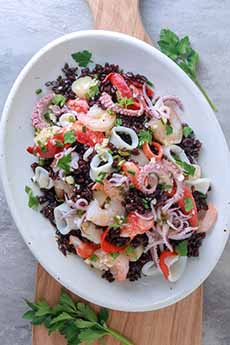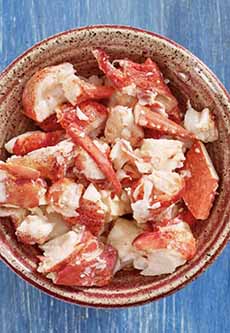RECIPE: Warm Seafood Salad With Black Rice
|
|
One of our favorite “diet” foods is marinated seafood salad: mussels, octopus, scallops, shrimp and squid with celery, olives, onions and pimento in a lemon vinaigrette. We make a couple of quarts at a time, and don’t stop eating it until it’s gone: for lunch, dinner, snacks on shredded lettuce. This related recipe is similarly a seafood lover’s dream. It doesn’t include mussels, but has lobster for some real luxury. For a touch of the exotic, there’s black rice. All cultivated rice originated from a single crop in China, around 10,000 years ago. That first crop mutated or was bred into hundreds of different cultivars, including long grain, short grain, sticky (glutinous) and colored. Different cultivars became preferable in different countries, such as jasmine rice in Thailand. Brown and white rice are mace from the same cultivar*; but rice evolved into black, pink, red and other hues. Black rice (photo #2), which becomes purplish black when cooked (photo #3), is a rarity. It can be regular or sticky; there is also black jasmine rice. The black color is due to a large amount of anthocyanin†, a powerful antioxidant that gives a purple or blue hue to açaí berries, blueberries, Concord grapes and eggplants. A smaller amount of anthocyanin gives a paler purple color to blood oranges, purple cauliflower and purple corn. According to a 2015 study, black rice evolved from a type of Japanese rice. A specific gene mutated, triggering the plant to produce large amounts of anthocyanin. Farmers then crossbred black rice mutants to produce more types. Riso venere (REE-zoe VEH-neh-ray) is a medium-grain hybrid that has a naturally black pericarp (the outermost skin of the grain). In Italian, the name means “Venus rice.” The Chinese cultivars of black rice could not adapt to cold European winters, but the hybrid does well in the Lombardy and Piedmont regions of Italy. Some Americans call the new hybrid “black vernere rice” or “black Venus rice.” The variety was created by Dr. Wang Xue Ren, a Chinese hybrid specialist. It is not genetically modified (that is, it is non-GMO) but is a hybrid of forbidden rice, also called emperor’s rice, a species that has grown in China for centuries. Until the 1800s it was cultivated only for the emperor and the nobility (hence, “forbidden” to others). Why Is Black Rice More Expensive? Black rice has a very low yield, often just 10% of other rice varieties. For centuries only royalty or other very wealthy people could afford it. It was called forbidden rice or emperor’s rice. Check out the different types of rice. Here are more ways to use black rice. Black rice is an easy way to add excitement to a dish. Beyond the stunning color, the whole grain rice has a nutty, sweet taste. The heat from cooking can turn the anthocyanins in the hull from black to dark purple (photo #3). Ingredients For 6 Servings |
|
|
Preparation 1. BRING 6 cups of water and salt to a boil in a large saucepan over medium-high heat. Add the squid and cook 3 minutes or until squid is just tender. Remove squid from pan with a slotted spoon and plunge into ice water. Drain the water and cut squid into 1-inch pieces, placing them in a large bowl. 2. ADD the shrimp to the boiling water and cook 3 minutes or until done. Remove the shrimp with a slotted spoon and plunge into ice water. Drain the water and add the shrimp to the bowl with the squid. 3. PLACE a vegetable steamer in the saucepan. Reduce the heat to medium-low. Arrange the scallops in the steamer and cook over simmering water 6 minutes, or until done. Remove the scallops from the pan with a slotted spoon and plunge into ice water. Drain and add scallops to the bowl with the squid and shrimp. Cover and refrigerate. 4. REMOVE the steamer from the saucepan. Add the octopus to simmering water, cover and simmer 2 to 2½ hours or until fork-tender (add additional water if necessary to cover the octopus as it cooks). Meanwhile… 5. COMBINE the lemon juice, garlic, parsley, chives, and salt and pepper in a mixing bowl. Slowly whisk in the olive oil to incorporate. Set aside or refrigerate. 6. PLACE the rice in a sieve and rinse under cold running water. Drain and add to a medium saucepan along with 2¾ cups of water. Bring to a boil before reducing to a simmer. Cook the rice with the lid ajar for 25-30 minutes, until all the liquid has been absorbed. Transfer to a bowl and set aside. 7. REMOVE the octopus when done and plunge into ice water. Drain and rub off the skin; cut into 1-inch pieces. Add the octopus, lobster, onion, and rice to squid mixture. How about Thai Rice Pudding with black rice? ________________ †Anthocyanins are flavonoids, a type of antioxidant.
|
||







